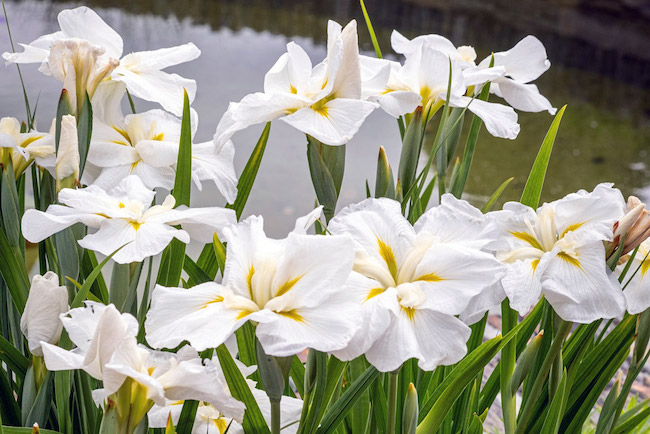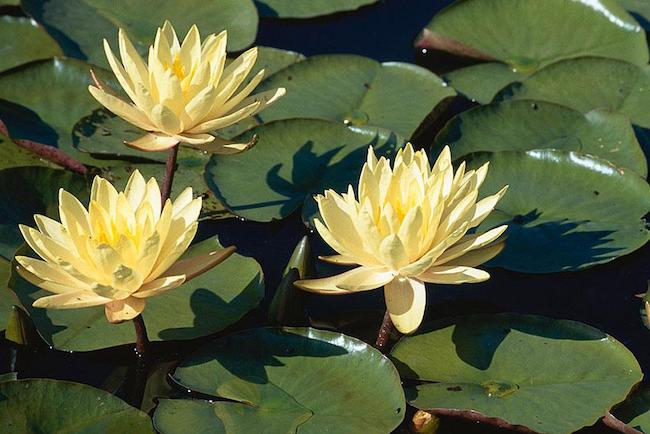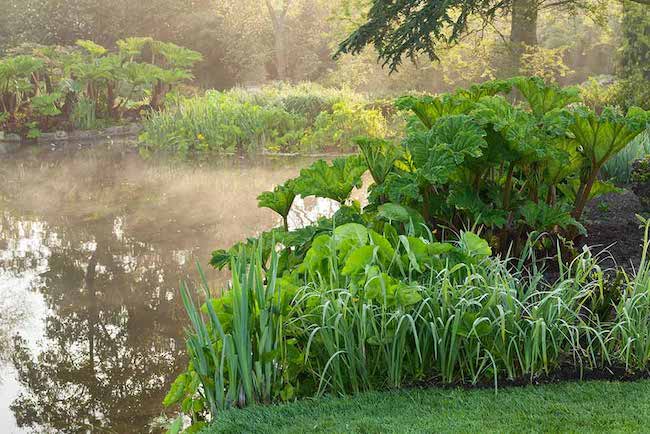Planting ideas for the pond

Iris-ensata-moonlight-waves

NymphaeaTexasDawn

Pond edge with gunner and iris
Gardens in the United Kingdom are renowned for their verdant beauty and natural charm. A quintessential element of these gardens is often a tranquil pond, providing a haven for aquatic life and a serene focal point for human enjoyment. Planting your garden pond is a creative and rewarding endeavour, and careful consideration of the plant species is crucial for creating a harmonious and thriving ecosystem. Whether you have a small backyard pond or a larger one, this guide will help you select the right plants, with a focus on those suitable for different depths of water.
Plants for the Margins (Shallow or Very Wet Areas)
The marginal area of your garden pond, where the water meets the land, is a crucial zone for both aesthetics and ecological balance. Here are some plant suggestions for these areas:
- Cyperus papyrus (Marginal Aquatic): With its striking umbrella-like foliage, papyrus adds an exotic touch to your pond’s edge.
- Hosta ‘T-Rex’ (Giant Plantain Lily): This hosta variety boasts enormous, textured leaves that create a lush, tropical feel around your pond.
- Primula vialii: Known as the “candelabra primula,” this plant features tall spikes of purple-pink flowers in late spring, adding vertical interest.
- Acorus gramineus ‘Variegatus’: With its pale yellow-striped leaves, this grass-like plant adds a pop of color and texture to your pond’s edge.
- Caltha palustris (Marsh Marigold): In early spring, this plant bursts forth with large golden flowers, making it a cheerful addition to your pond.
- Carex elata ‘Aurea’ (Bowles’ Golden Sedge): Its golden foliage brightens up the margins and complements other plantings.
- Iris ensata: Japanese water iris offers blue, red, or white flowers on sturdy stems, adding a touch of elegance.
- Veronica beccabunga (Brooklime): White-centred blue flowers make this a delicate choice for the pond’s edge.
Floating Plants
Floating plants not only add beauty but also provide shade and shelter for aquatic creatures. Here are two options for your garden pond:
- Hydrocharis morsus-ranae (Frogbit): Small white flowers and floating leaves make this a delightful choice. It may sink in winter but will return in spring.
- Stratiotes aloides (Water Soldier): Floating just below the surface, this plant forms rosettes of leaves and adds visual interest. However, it can become invasive in smaller ponds.
Plants for Water 5 to 15 cm Deep
The area of your pond that is 5 to 15 cm deep offers a unique opportunity to showcase a variety of plants. Here are some recommendations:
- Acorus calamus ‘Argenteostriatus’ (Sweet Flag): Its creamy-white variegated foliage stands out in this shallow zone.
- Butomus umbellatus (Flowering Rush): This plant produces pink flowers in summer, reminiscent of miniature agapanthus blooms.
- Iris laevigata: With rich blue flowers in June, this iris adds vibrant color to your pond’s shallows.
- Juncus effusus f. spiralis (Corkscrew Rush): Its twisted corkscrew stems add a unique and playful texture.
- Lobelia cardinalis: Known for its purplish foliage and scarlet flowers, it’s a stunning addition but may need winter frost protection in some regions.
- Pontederia cordata (Pickerel Weed): With glossy leaves and blue flowers in late summer, it’s a striking choice for your pond’s margins.
- Ranunculus lingua ‘Grandiflorus’ (Large-Flowered Spearwort): Tall stems and large yellow buttercup flowers create a bold statement.
- Sagittaria sagittifolia (Old World Arrowhead): The double white-flowered form ‘Flore Pleno’ is particularly attractive.
Water 15–30cm (6in–1ft) Deep
The deeper waters of your pond provide the perfect canvas for some unique aquatic plants:
- Menyanthes trifoliata (Bog Bean): With its olive-green trefoil leaves and pinkish white spring flowers, it adds elegance to the shallower depths.
- Ranunculus flammula (Lesser Spearwort): Bright yellow flowers bring a burst of color to this zone.
- Thalia dealbata: Its bold blue-green leaves are a standout feature in the deeper waters of your pond.
- Zantedeschia aethiopica (Arum Lily): The fragrant white spathe and golden spadix make this plant a classic choice.
Water 30cm (1ft) or More
In the deepest parts of your pond, these plants thrive:
- Alisma plantago-aquatica (Great Water Plantain): With its white flowers, it’s a majestic addition, but take care to remove dead flowers to prevent seeding.
- Aponogeton distachyos (Water Hawthorn): Tuberous and fragrant, it adds an exotic touch to your pond. Be cautious about water snails, which can harm it.
Water Lilies
Water lilies are iconic and add beauty to your pond. Select the appropriate varieties based on the depth of your water:
- Water 10–30cm (4in–1ft) Deep:
- Nymphaea odorata var minor: Fragrant and pink.
- N. tetragona: White.
- N. ‘Pygmaea Helvola’: Yellow flowers and marbled leaves.
- N. ‘Pygmaea Rubra’: Free-flowering and red.
- Water 30–45cm (1–1½ft) Deep:
- Nymphaea ‘Aurora’: Cream opening yellow to orange.
- N. ‘Caroliniana Nivea’: Fragrant and white.
- N. ‘Charlene Strawn’: Lemon yellow.
- N. ‘Ellisiana’: Red.
- N. ‘Fire Crest’: Deep pink.
- N. ‘Froebelii’: Dark red.
- N. ‘Indiana’: Apricot-orange.
- N. ‘Laydekeri Fulgens’: Early free-flowering and red.
- N. ‘Laydekeri Lilacea’: Fragrant and rosy-lilac.
- N. ‘Lucidia’: Free-flowering and pink.
- N. ‘Mme Wilfon Gonnère’: Double pink.
- N. ‘Pink Sensation’: Pink.
- Water 45–75cm (1½–2½ft) Deep:
- Nymphaea ‘Gonnere’: Fragrant and white.
- N. ‘Amabilis’: Tulip-shaped flowers, salmon pink
- N. ‘Attraction’: Red flowers darkening with age
- N. ‘Escarboucle’ AGM: Free flowering, red
- N. ‘Gladstoneana’ AGM: Free flowering, white